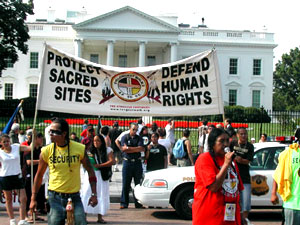ASKIAM
-Senior Correspondent-
THE WHITE HOUSE (FinalCall.com) – When militant Native American activists captured Alcatraz Island in the San Francisco Bay, reclaiming it as Indian land more than 30 years ago, the group was referred to in the local White-media as “Red Muslims,” hoping that linking them with not-well-spoken-of Nation of Islam “Black Muslims” would tarnish their reputation.

They continued to organize, and in 1978 marched 3,600 miles from Alcatraz, arriving in Washington 40,000 strong to protect Native rights and sovereignty.
To commemorate the 30th anniversary of that historic march, 1,000 Indians and their supporters arrived here July 11, with drums, and chants and prayers concluding a five-month, combined 8,000 mile march that took one group along the historic 3,600 mile route and another on a 4,400 mile southern course. It was “The Longest Walk 2,” and they carried the message “All Life is Sacred, Protect Mother Earth.”
“The Longest Walk is an environmental walk. It’s also walking for issues of Native American interest, Native issues, the most important being sacred sites and the environment,” organizer Dennis Banks, who participated in the original 1978 Longest Walk, told Pacifica Radio’s “Democracy Now!”
At the White House leaders emphasized the spiritual power which guided their steps. “Renewing the Spirit by Walking in the Footsteps of our Ancestors,” was the focus of one group of Native walkers, who left San Francisco Feb. 11. This Longest Walk 2 took participants once again, across the sacred grounds of living sovereign nations.
The other group walked the southern route in the Clean Up Mother Earth campaign, in which walkers picked up trash as they walked, organizers said.
Along the way they picked up 3,800 bags of trash and gathered a list of American-Indian worries–everything from concern about burial grounds under threat in Kentucky to fears about the future of Arizona Mountains threatened by a ski resort.
In 1978 the first Walk was organized when 11 bills in Congress threatened to abrogate U.S. government treaties with Indian tribes. Hundreds of Indians walked from the Alcatraz to Washington in a peaceful, spiritual effort to educate the public about Native American rights and the native way of life.
That walk helped to gather enough support to halt the proposed legislation abrogating Indian treaties. In addition, the walk resulted in the passage of the American Indian Freedom of Religion Act of 1978, allowing Native Americans to legally practice their traditional religions for the first time since 1492.
One of the features of this march was broad solidarity across racial and religious boundaries, based on what organizers insist is the justice of their cause. “In 1978, we raised the issue of (Leonard) Peltier’s innocence and how he was, I felt, wrongly committed, convicted, on fabricated evidence. And just, to me, it was just innuendos,” said Mr. Banks in the radio interview.
“In the 1978 walk we were joined by many, many tribes, and then also from Japan came the Buddhist monks and nuns of Nipponzan Myohoji. And I want to say ‘Namu myoho renge’ to them, because again they’re joining us, and we have approximately 29 Japanese with us. And a lot of our people are learning to expand our horizon of people and culture worldwide. There’s people from Australia, Germany, France. We have a big diverse group of people,” Mr. Banks explained
The marchers ended their journey, leaving the White House to present a 30-page manifesto to Rep. John Conyers, chairman of the House Judiciary Committee and an ally on a wide range of social justice, criminal justice, and issues of concern to Blacks and other members of racial minority groups.












